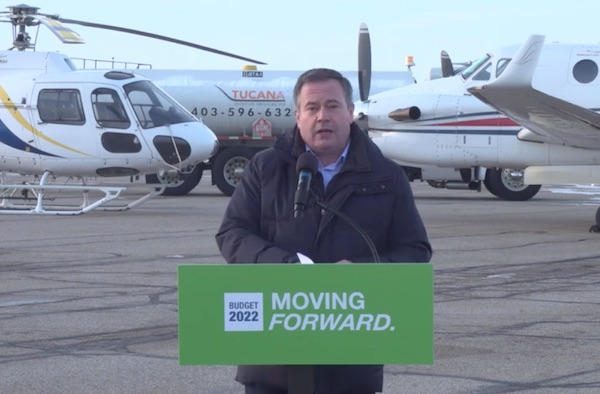Alberta
Red Deer Regional Airport expansion takes flight

Alberta’s government will provide a $7.5-million grant to expand infrastructure and services at the Red Deer Regional Airport.
An $18-million airport expansion project will include widening the runway and constructing a terminal to support new low-cost passenger services.
These improvements will help the Red Deer Regional Airport attract new passenger and cargo services and offer a wider range of travel options to area residents, increasing the region’s tourism potential. More than 100 jobs will be created during construction.
Quick facts
- Construction tenders will be issued this month. Work is schedule to begin this spring and conclude in fall 2022.
- Airport improvements include widening the main runway from 30 to 45 metres, strengthening existing taxiways and aprons, and constructing a terminal to support low-cost passenger services.
- The anticipated total cost of the airport expansion is $18 million – with $7.5 million from Alberta’s government.
- Alberta’s aviation, aerospace and logistics industries employed nearly 71,000 people in 2020. These industries contributed $7.2 billion to the province’s GDP in 2020.
- Alberta’s aviation industry has been ranked third in Canada by company size, fourth by number of companies and fourth by GDP contribution in aerospace and defence.
- Alberta’s government created the Strategic Aviation Advisory Council in 2020 to provide expert advice to government on how aviation and aerospace can increase economic development opportunities, expand markets and create jobs in the province.
- Expanding the aviation sector is a key goal of Alberta’s Recovery Plan.
- Three low-cost Alberta based-carriers – the recently created Lynx Air, along with new routes added by Swoop and Flair Airlines – are strong signs of the province’s growing aviation industry.
This investment in Alberta’s aviation industry helps the province further diversify the economy and create more jobs, growth and prosperity. The industry employed more than 71,000 people in 2020, and it continues to grow thanks in part to the Alberta Recovery Plan.
“Central Albertans need a modern, expanded airport that will serve businesses, create jobs and give travellers more choice in airline options. Alberta’s government will make this project happen through this $7.5-million Budget 2022 investment.”
“The aviation sector is a vital part of Alberta’s Recovery Plan and this project will be a great boost to the Red Deer and central Alberta economy. This airport funding will attract more investment and new opportunities for residents and businesses.”
“My optimism around economic opportunities in central Alberta is growing, thanks to this commitment to our airport. We will be able to diversify our economy while creating good-paying jobs and tourism potential.”
“Alberta is an economic powerhouse and the Red Deer airport is strategically centred in the dynamic Calgary-Edmonton corridor. This investment will position our airport to leverage its natural competitive advantages as Alberta and central Alberta prospers and grows.”
“Being able to expand on the airport’s rich history will improve economic opportunities across the region, attract investment and put people back to work. This grant shows everyone that central Alberta is a key contributor to our economic recovery.”
“Now more than ever, aviation and aviation-related businesses are actively looking for alternatives to the ever-increasing costs associated with operating out of large airports. With low lease rates, free parking and no airport improvement fees, the Red Deer Regional Airport is well-positioned for future growth.”
“This expansion will provide huge economic benefits to central Alberta. Red Deer County is appreciative of this important investment from the Alberta government and the continuing commitment to build economic prosperity.”
“The Red Deer Regional Airport is a regional amenity that supports the whole of Alberta. This investment translates to not only potential for increased passengers, revenues and regional economic development, but also opportunities to generate employment at a time when the economy and travel industry needs it most.”
Alberta
School defunding petition in Alberta is a warning to parents

This article supplied by Troy Media.
A union-backed petition to defund independent schools in Alberta could trigger a wave of education rollbacks across Canada
A push to defund independent schools in Alberta is a warning to every Canadian parent who values educational options.
A petition backed by the Alberta teachers’ union may be the first step toward reduced learning choices across Canada. Independent schools, most of them non-elite and often focused on a specific pedagogical approach, receive partial public funding in Alberta and serve diverse student populations.
The petition, launched under Alberta’s citizen initiative law, could trigger a provincewide referendum if it meets the required threshold set by provincial election law.
If your child isn’t in a standard public classroom, whether they’re home-schooled, in a charter, Francophone, Catholic, or
specialized public program, this petition puts your educational decisions at risk.
Opponents of choices in education have been forthright in their attempts to erode the large and successful range of learning options that most Canadians enjoy. Instead, they seem to be aiming for a single, uniform, one-size-fits-all system with no variation for children’s many learning styles and needs, nor for new teaching innovations.
During last year’s NDP leadership campaign in Alberta, candidate (and current MLA) Sarah Hoffman proposed effectively eliminating charter schools and forcing them to join public school boards.
The current recall effort targeting Alberta Education Minister Demetrios Nicolaides lists “charter-private school” funding as a rationale. There is no such thing as a charter-private school, since charter schools are public and 100 per cent provincially funded.
It’s clear the petition is aimed at restricting or defunding charter schools despite their popularity. More than 15,000 students are enrolled and over 20,000 more are on wait-lists in Alberta.
Alberta isn’t the only place where schooling options are coming under pressure. Yukon’s NDP leader has called for defunding and eliminating the territory’s entire Catholic separate system. Similar arguments exist in Ontario. British Columbia doesn’t have a Catholic school system. Newfoundland had one, but in 1998 merged the Catholic board into the public one.
Going as far back as 2010, provinces including Newfoundland, British Columbia, P.E.I. and Nova Scotia have sought to justify limiting the Francophone schooling options they offer due to high costs and budget limitations.
These provincial actions raise a larger question. Efforts to defund Catholic and Francophone schooling are striking, given that both are constitutionally protected. If, as teachers’ unions argue, even constitutionally protected choices can be defunded, restricted or eliminated, how safe are all the other options, like independent, charter, or microschools that aren’t written into the constitution but excel at producing well-formed, knowledgeable graduates ready for adulthood?
Even specialized programs offered within the public system aren’t safe. Last year, the Calgary Board of Education shut down its all-boys program, saying the space was needed to accommodate general enrolment growth. However, the building was then leased out to a post-secondary institution. In Vancouver, the public board stopped new enrolment in its gifted student program, ending “the only publicly funded option for kids who need an accelerated learning environment.”
If these formal attacks on educational diversity can happen in Alberta, which has long been Canada’s leader in making a wide variety of learning options available, affordable and accessible to families, then it certainly can happen in other provinces as well.
The Saskatchewan Teachers’ Federation has already asked the government to end funding for independent schools. A similar push has surfaced in British Columbia. The claim that independent schools drain resources from the public system is incorrect. Every student who enrolls in an independent school costs the provincial budget less and frees up space, teaching time, and other public school resources for everyone else.
These efforts reflect a zero-sum view of education and a false view that only some schools serve the common good.
A better approach is to expand what’s available. Provinces can support more learning options for families, which means more resources and better results for students, no matter how or where they learn.
We need to pay attention to what’s happening in Alberta and elsewhere. Parents don’t want fewer options to help their children enjoy school and flourish academically or personally. If educational diversity can be rolled back in Alberta, it can be rolled back anywhere.
Canadians who value educational alternatives need to pay attention now—before the decisions are made for them.
Catharine Kavanagh is western stakeholder director at Cardus, a non-partisan thinktank that researches education, work and public life.
Troy Media empowers Canadian community news outlets by providing independent, insightful analysis and commentary. Our mission is to support local media in helping Canadians stay informed and engaged by delivering reliable content that strengthens community connections and deepens understanding across the country
Alberta
Alberta government’s plan will improve access to MRIs and CT scans

From the Fraser Institute
By Nadeem Esmail and Tegan Hill
The Smith government may soon allow Albertans to privately purchase diagnostic screening and testing services, prompting familiar cries from defenders of the status quo. But in reality, this change, which the government plans to propose in the legislature in the coming months, would simply give Albertans an option already available to patients in every other developed country with universal health care.
It’s important for Albertans and indeed all Canadians to understand the unique nature of our health-care system. In every one of the 30 other developed countries with universal health care, patients are free to seek care on their own terms with their own resources when the universal system is unwilling or unable to satisfy their needs. Whether to access care with shorter wait times and a more rapid return to full health, to access more personalized services or meet a personal health need, or to access new advances in medical technology. But not in Canada.
That prohibition has not served Albertans well. Despite being one of the highest-spending provinces in one of the most expensive universal health-care systems in the developed world, Albertans endure some of the longest wait times for health care and some of the worst availability of advanced diagnostic and medical technologies including MRI machines and CT scanners.
Introducing new medical technologies is a costly endeavour, which requires money and the actual equipment, but also the proficiency, knowledge and expertise to use it properly. By allowing Albertans to privately purchase diagnostic screening and testing services, the Smith government would encourage private providers to make these technologies available and develop the requisite knowledge.
Obviously, these new providers would improve access to these services for all Alberta patients—first for those willing to pay for them, and then for patients in the public system. In other words, adding providers to the health-care system expands the supply of these services, which will reduce wait times for everyone, not just those using private clinics. And relief can’t come soon enough. In Alberta, in 2024 the median wait time for a CT scan was 12 weeks and 24 weeks for an MRI.
Greater access and shorter wait times will also benefit Albertans concerned about their future health or preventative care. When these Albertans can quickly access a private provider, their appointments may lead to the early discovery of medical problems. Early detection can improve health outcomes and reduce the amount of public health-care resources these Albertans may ultimately use in the future. And that means more resources available for all other patients, to the benefit of all Albertans including those unable to access the private option.
Opponents of this approach argue that it’s a move towards two-tier health care, which will drain resources from the public system, or that this is “American-style” health care. But these arguments ignore that private alternatives benefit all patients in universal health-care systems in the rest of the developed world. For example, Switzerland, Germany, the Netherlands and Australia all have higher-performing universal systems that provide more timely care because of—not despite—the private options available to patients.
In reality, the Smith government’s plan to allow Albertans to privately purchase diagnostic screening and testing services is a small step in the right direction to reduce wait times and improve health-care access in the province. In fact, the proposal doesn’t go far enough—the government should allow Albertans to purchase physician appointments and surgeries privately, too. Hopefully the Smith government continues to reform the province’s health-care system, despite ill-informed objections, with all patients in mind.
-

 armed forces11 hours ago
armed forces11 hours agoIt’s time for Canada to remember, the heroes of Kapyong
-

 International2 days ago
International2 days agoBBC uses ‘neutrality’ excuse to rebuke newscaster who objected to gender ideology
-

 Agriculture2 days ago
Agriculture2 days agoThe Canadian Food Inspection Agency’s Bloodlust for Ostriches: Part 2
-

 Housing2 days ago
Housing2 days agoTrump advancing 50-year mortgage to help more Americans buy homes
-

 Agriculture2 days ago
Agriculture2 days agoWas The Ostrich “Cull” A Criminal Act?
-

 International2 days ago
International2 days agoBBC boss quits amid scandal over edited Trump footage
-

 Frontier Centre for Public Policy2 days ago
Frontier Centre for Public Policy2 days agoNotwithstanding Clause Is Democracy’s Last Line Of Defence
-

 Daily Caller2 days ago
Daily Caller2 days agoMcKinsey outlook for 2025 sharply adjusts prior projections, predicting fossil fuels will dominate well after 2050









